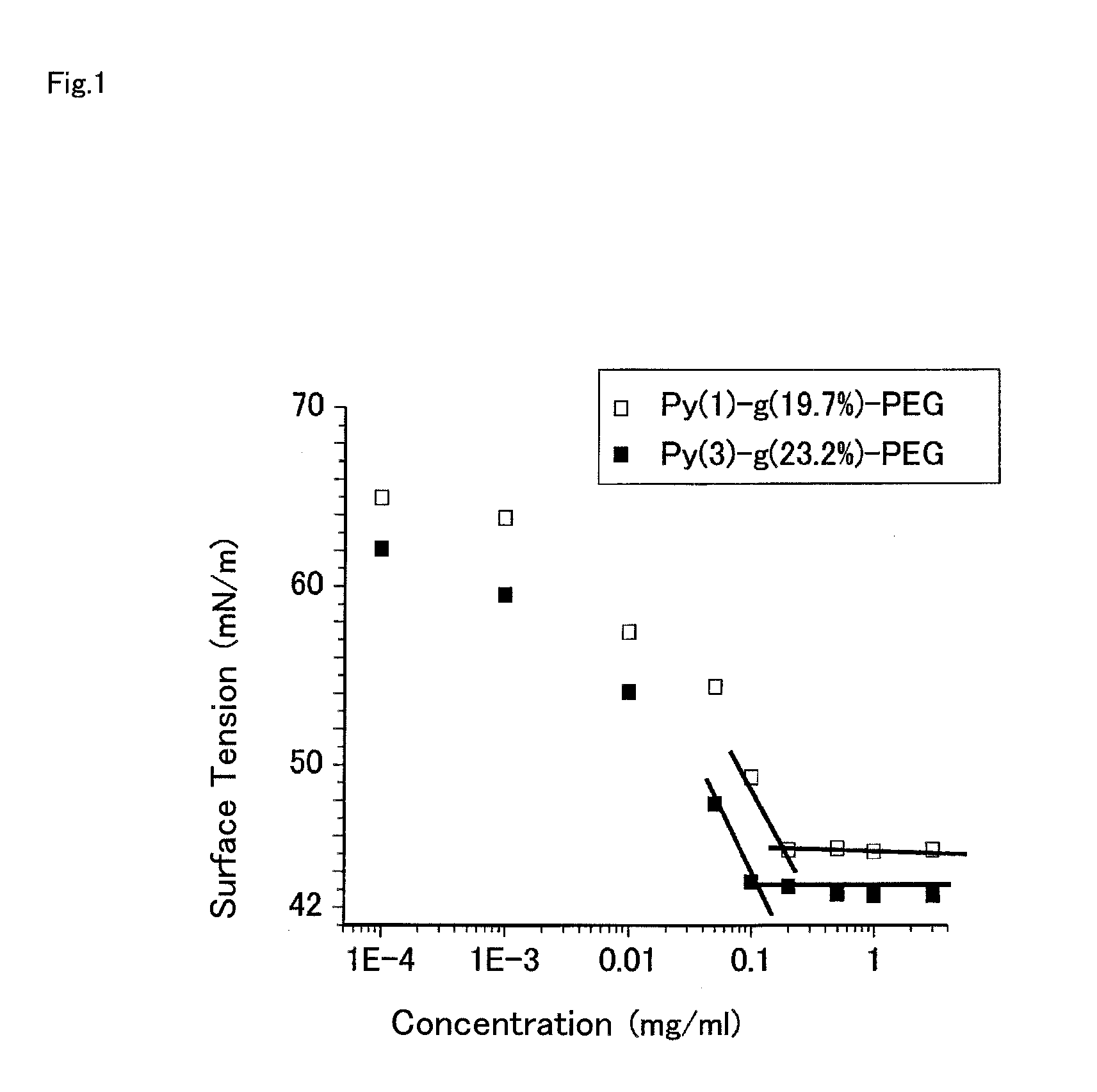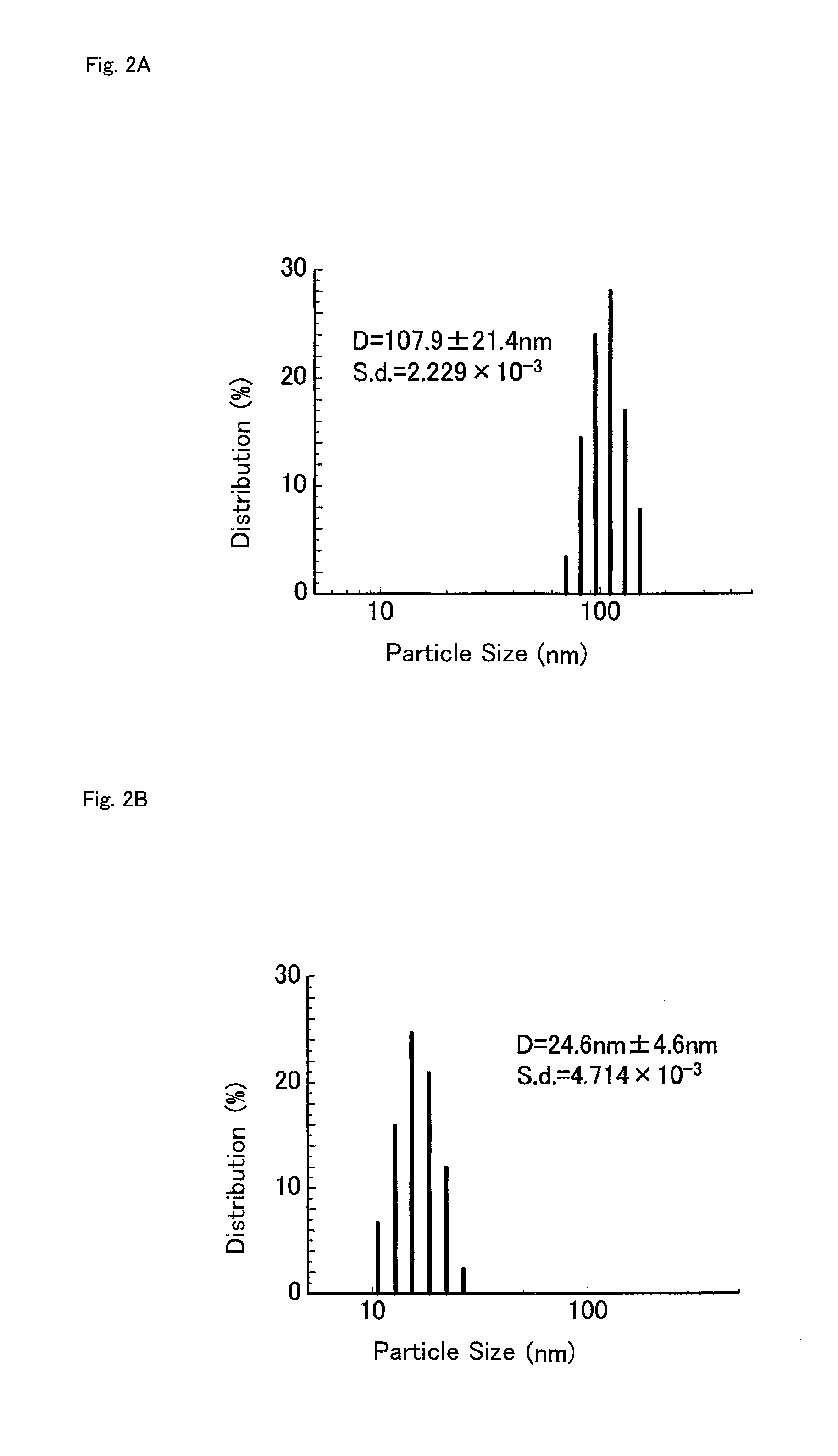Polymerizable monomer, graft copolymer, and surface modifier
a polymerizable monomer and copolymer technology, applied in the field of polymerizable monomers, graft copolymers, and surface modifiers, can solve the problems of difficult grafting of polymerizable monomers having thiol groups, and achieve the effects of general versatility, stable particle size, and stable dispersion
- Summary
- Abstract
- Description
- Claims
- Application Information
AI Technical Summary
Benefits of technology
Problems solved by technology
Method used
Image
Examples
synthesis example 1
Case of Alkylene Group Having a Carbon Number of 1: m=1
[0148]After 5.45 g (50 mmol) of 4-pyridinemethanol (manufactured by Aldrich Co.), 4.73 g (55 mmol) of methacrylic acid (manufactured by Aldrich Co.), and 740 mg (5 mmol) of 4-(1-pyrrolidinyl)pyridine (manufactured by Aldrich Co.) were dissolved in 100 ml of anhydrous dichloromethane (manufactured by WAKO Co.), 11.3 g (55 mmol) of N,N′-dicyclohexylcarbodiimide (DCC) (manufactured by Aldrich Co.) was added thereto and allowed to react at room temperature for 1 hour. Then, insoluble urea was removed by filtration, followed by removal of solvent under reduced pressure. The residual material was purified by column chromatography (column: silica (manufactured by WAKO Co.), solvent: hexane / ethyl acetate) to obtain 8.1 g (46 mmol) of a colorless oil (yield rate: 91%).
synthesis example 2
Case of Alkylene Group Having a Carbon Number of 3: m=3
[0149]After 6.85 g (50 mmol) of 4-pyridinepropanol (manufactured by Aldrich Co.), 4.73 g (55 mmol) of methacrylic acid, and 740 mg (5 mmol) of 4-(1-pyrrolidinyl)pyridine were dissolved in 100 ml of anhydrous dichloromethane, 11.3 g (55 mmol) of DCC was added thereto and allowed to react at room temperature for 1 hour. Then, insoluble urea was removed by filtration, followed by removal of solvent under reduced pressure. The residual material was purified by column chromatography (column: silica (manufactured by WAKO Co.), solvent: hexane / ethyl acetate) to obtain 8.5124 g (41.4 mmol) of a colorless oil (yield rate: 82.8%).
synthesis example 3
Case of Alkylene Group Having a Carbon Number of 5: m=5
[0150]9-Borabicyclo[3.3.1]nonane (9-BBN) dissolved in 15 ml of tetrahydrofuran (manufactured by Aldrich Co.) was added to 300 mg (3.483 mmol) of 4-pentene-1-ol and allowed to react at 25° C. for 24 hours. Then, 4-bromopyridine hydrochloride (manufactured by Aldrich Co.) dissolved in water / dimethylformamide (DMF) at a ratio of 2:8, tetrakis(triphenylphosphine)palladium (manufactured by Aldrich Co.), and potassium carbonate (manufactured by Aldrich Co.) were added thereto in an equivalent ratio of 1:1.2:0.2 and allowed to react at 70° C. for 6 hours. Then, solvent was removed under reduced pressure, and the residual material was diluted with ethyl acetate and filtered with Celite. The material thus obtained was purified by column chromatography (column: silica (manufactured by Aldrich Co.), solvent: ethyl acetate / hexane) to obtain 203 mg of pyridinepentanol (yield rate: 48%). The reaction scheme is shown below.
[0151]
[0152]After 11...
PUM
| Property | Measurement | Unit |
|---|---|---|
| carbon number | aaaaa | aaaaa |
| temperature | aaaaa | aaaaa |
| temperature | aaaaa | aaaaa |
Abstract
Description
Claims
Application Information
 Login to View More
Login to View More - R&D
- Intellectual Property
- Life Sciences
- Materials
- Tech Scout
- Unparalleled Data Quality
- Higher Quality Content
- 60% Fewer Hallucinations
Browse by: Latest US Patents, China's latest patents, Technical Efficacy Thesaurus, Application Domain, Technology Topic, Popular Technical Reports.
© 2025 PatSnap. All rights reserved.Legal|Privacy policy|Modern Slavery Act Transparency Statement|Sitemap|About US| Contact US: help@patsnap.com



